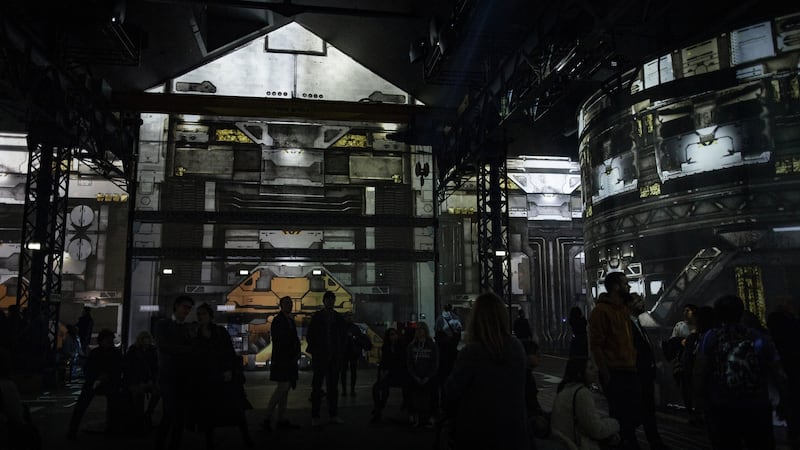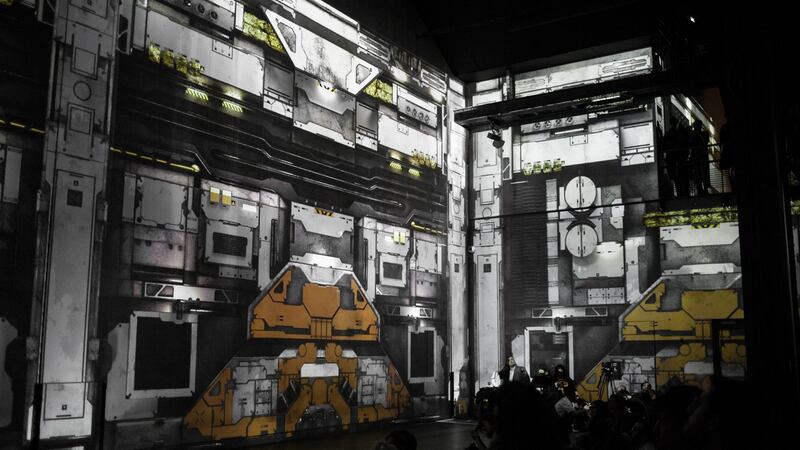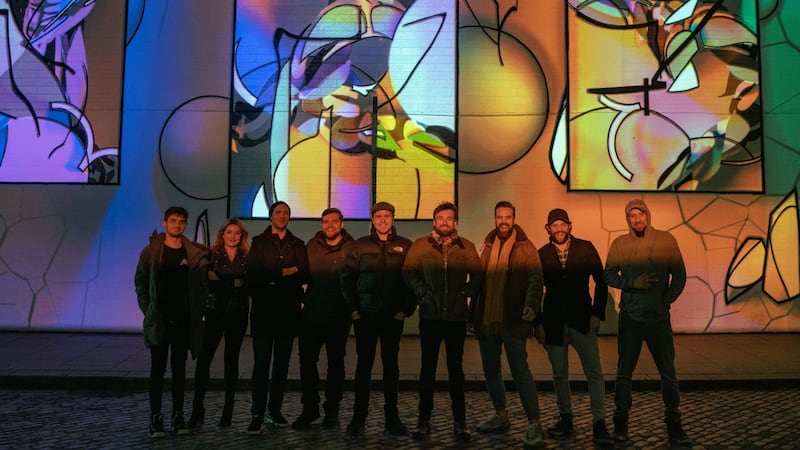As pipes creak into overload, a calm and robotic voice runs a countdown until destruction. The system is glitching. Smoke rises and snarling monsters whip their tails through the wires. Blue flames burn through metal, directing us to the outer world, where the skies are clear, the grass is green and butterflies flutter about. This is Portals, the fully immersive film by the Dublin creative production studio Algorithm.
Portals is one of the 10 projection mapping pieces that competed in the Immersive Art Festival – one of the first festivals dedicated to graphic and immersive digital design – in Atelier des Lumières, Paris, and Algorithm is the only Irish studio shortlisted.
For one week in October, their work was shown with some of the world’s best digital artists in a museum that takes in 1.2 million visitors annually for immersive exhibitions showcasing the work of Gustav Klint and Vincent Van Gogh.
With suitably eerie sound design by Simon Cullen and deliciously dark and demented animations by Dillon O'Sullivan and Ted O’Donoghue, the piece juxtaposes the “beauty and unspeakable horrors in the world”. Running for four minutes in total, if you were to combine each feed of projected animation on the 22 surfaces, it would play for 122 minutes; the average length of a feature film.

Algorithm creative director and co-founder Daniel Staines explains the power of projecting in a space as large and prolific as Atelier des Lumières. “For us, it was about trying to show that you can transport people to a different place within this space. So it’s like a holodeck,” he says, referring to the virtual reality room in Star Trek.
Exhibited alongside studios from France (Cokau Lab, HKI, Les Vandales, Roman Hill and Paul Mignot, Spectrelab, Superbien), Turkey (Nohlab, Ouchhh, Void) and Belgium (Create.eu), the festival offered 140 video projectors, 50 speakers and 3,000 sq m of surface over 7.6m high walls for the studios to experiment with.
The scale of the project only became evident during the designing process. “We thought that we could just do what we usually do but bigger and that’s not how it works,” says Algorithm managing director and co-founder Nick Linders. “It’s like quantum mechanics. Standard physics works up to a point and then at either end of the scale, everything goes mental.”
“It was a huge technical challenge,” says Staines.
Pillars, balconies, floors, mirrored rooms and water pools were their blank canvas and the team initially used gaming technology to create highly defined, textured effects – highlighting volume, shadow and light – for the walls. However, gaming software has its limitations, especially when working with massive resolutions. After three weeks of using that approach, the team went back to what they know; modelling everything in 3D and rendering it out as video.
“Once we did that and built everything and put it into our rendering software, our software just died completely,” he says. “It couldn’t handle it because it was just way too much. We had to change to a different software and learn this from scratch very late in the day. It was exciting and very scary.”
Motion and digital designers
Overcoming the issues that working with 246 million pixels can trigger, Portals and the Algorithm team made it to Paris for the launch of the festival. Entirely sold out to the public, this festival allowed visitors to get lost in space, wander the deserts, hop through Wonderland, navigate imploding black holes, outrun falling skyscrapers, skip through linear dimensional realms and experience a sci-fi reactor go into meltdown. If you have ever imagined infinity or the end of days, it was projected within these walls. The winning studio, Turkey’s Nohlab, endeavoured to capture the process of how the human brain turns “protons into perceivable forms” in Journey. Simple? Hardly.
What this festival demonstrated is that immersive digital art is almost definitely the future of art consumption and Algorithm – and the other competing studios – are the ones pushing the boundaries that will bring it into existence.

“This festival can show to the main audience a new type of art; digital design art,” says Michael Couzigou, the director of the festival and Atelier des Lumières. “Motion Designers and digital designers are real artists, and it’s important to show their art to the public.”
Couzigou met Algorithm members Cormac Murray and Kevin Freeney at Digital Design Days conference in Milan last year. “When I met Algorithm at DDD Milan, I was really impressed by their skills in motion design,” he says and, from there, he invited them to take part in the very first edition of the festival.
Based on Capel Street, Algorithm became a studio in 2015 but its creative founders – Murray, Freeney, Staines, Linders, Lewis Byrne and Olan Clarke – have been a vital part of projection mapping for live music in Ireland since 2006. Making their start during the financial crash, they took opportunities where they could find them. Working as Slipdraft, Staines and Murray used Block T, the creative collective that was co-founded by Linders and located in an empty unit above an Asian supermarket in Smithfield, as a testing ground for techniques that they saw online. “It was around the time that we all got computers at home and around the time that YouTube was coming out. We saw all these videos but we’d never seen it in real life. There was no opportunity to see it in Ireland so we were like ‘we’ll just have to do it ourselves’,” says Staines. And they did.
Their first projection-mapping gigs consisted of taping patterns on to breezeblock walls for collaborative shows with the post-rock instrumental band Alarmist. These gigs happened in the recently demolished Block T and Block B, another then-empty Smithfield unit where the creative agency Rothco now has its Dublin headquarters.
Soon after, they found Byrne, Clarke and Freeney, who then operated as Algorhythm, and their first joint production was Electric Picnic’s Rave in the Woods stage in 2012. Here they built a visually integrated stage using a grid of empty water containers that were lit up from the inside using IBC lighting tags.
The team has since evolved into a 14-person strong studio and it’s very likely that you’ve seen their work projected on to the walls of Curraghmore House at All Together Now 2018, the main stage at Life Festival 2017, the second stage at Metropolis 2016 or emblazoned across the stage for Kodaline and Picture This’s sold-out shows in Dublin’s 3Arena this year. Looking back on the early days, Staines remarks: “We just wanted to see how weird we could get it”.
Lack of spaces
Dublin now and the Dublin that Algorithm first started working in are different beasts. When artists once had low-rent spaces to create and exhibit in, those spaces are now being developed into what seems like an endless stream of hotels.
“We hear people saying that the boom is back but that doesn’t seem to be translating into a richer arts and cultural centre,” says Linders. “Ireland has a really strange relationship with arts and culture. As a society, we love talking about it. We love owning it. But we don’t fund it very well. We have some of the lowest arts funding per capita in Europe.”

Focusing on the lack of spaces to display art at home, Linders homes in on the idea of pro-social public art and refers to Perpetua, the self-funded, interactive mural they created with James Earley in March. Projecting a graffiti mural designed by Earley, Staines, Murray and motion designer Ross Ryder on to their old haunt Block T, their animation team designed a series of looks that viewers could play with on an interactive touchscreen from the windows of Rothco. “We had people from all over the Smithfield community just engaging with it, watching it, recording it and showing it to their friends, from local kids to office workers and people in the apartments,” he says.
“There’s a part of that that’s important in how we build communities. Dublin has a serious problem with communities at the moment,” he says, noting the loss of the Dublin Flea Market in Newmarket Square as an example. “Art brings a community together because it isn’t for any one group or one person. It’s a piece of art. It’s interpretative. It’s representative. It’s whatever the people want and it’s often better than a faceless office building.”
Having had the opportunity to go abroad and participate in something as risk-taking as the Immersive Art Festival, Algorithm proved that they’re not just maintaining their standards but they’re raising them. “When we saw the space, we were like ‘jeez, this is incredible’. Our jaws were on the floor,” says Staines. “We saw so much potential in it and we thought that this is the place where we can finally do our thing and explore these ideas that we’ve had for so long.”
Linders believes that there’s a space for something like Atelier des Lumières in Dublin, even if it’s something that they have to create themselves. “I find it interesting that we don’t always marry the two ideas of Ireland’s cultural heritage and the Fleadh down the country to the fact that we’re one of the fastest growing economies and tech capitals in the world,” he says. “So I think something like Atelier and digital art has a potential ability to do that because you’re marrying the story of Brian Boru with some crazy digital interactive piece. We haven’t done that yet.
“Ireland has some amazing creative talent and amazing animation talent and technology talent in the world and with all the hotels we’re building in Dublin, we are certainly expecting a huge amount of tourists to come so we’re going to need things for them to do.”











